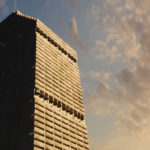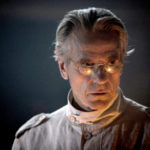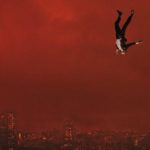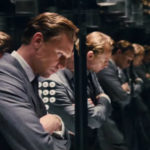“There’s no food left. Only the dogs. And Mrs. Hillman is refusing to clean unless I pay her what I apparently owe her. Like all poor people, she’s obsessed with money” – Ann (Keeley Hawes) in High Rise
“Chaos was the law of nature; Order was the dream of man.”
― Henry Adams, The Education of Henry Adams
My son saw Ben Wheatley and Amy Jump‘s film adaptation of JG Ballard‘s allegorical novel High Rise and thought Stanley Kubrick, especially Clockwork Orange and The Shining; I saw it and thought Lindsay Anderson, particularly Britannia Hotel for use of a building and its inhabitants as a crude metaphor for society, notably the class system.
I’ve also heard it compared to Woody Allen in a darkly comic way, and a variety of books and movies with dystopian outcomes, of which there are many (start with Golding‘s Lord of the Flies.) For that matter, the scenes where the wealthy on the upper floors try, unsuccessfully, to continue their genteel and decadent lives and power games, largely ignore the seething turmoil below, reminded me of GB Shaw‘s The Apple Cart.
Wheatley’s style is both startlingly original (see the disturbing Civil War movie A Field in England or the deliciously inky black comedy Sightseers to get a measure) and yet he filters in Tarantinoesque nods to his forebears.
There is much about High Rise that will seem familiar, not least because it is very firmly set in the 60s but projecting a gleaming vision of the 70s as the prestressed concrete edifices of post-modern architecture, an altar to dashed hopes in hindsight, which its architect Royal (also no accident), played by Jeremy Irons as an English Goldfinger, had seen as a “crucible of change” (later Royal says that rather than having not enough ingredients, he had too many…) This in turn reminds me of the much-detested and now demolished Hulme flats in Manchester – a vision of the future becoming a modern ghetto before you can say “post-modernism.”
The main protagonist in this parable is psychiatrist Robert Laing (the achingly fashionable Tom Hiddleston), whose name tag on RD Laing, and indeed his work on psychosis, is anything but accidental. This Laing is a cool and self-sufficient dude who recently lost his sister. He dresses smartly, is clearly well-bred and spoken, and has chosen to move in on the 25th floor of the latest flashy high rise. The affluent and aristocratic are lodged in the penthouses around the 40th floor, where the lower floors are dominated by the working classes with howling children.
The film begins with the post-apocalyptic chaos of a world reminiscent of Mad Max but for it being set in the destroyed penthouses. Everyman Laing works, enjoys the sunshine of a lazy day and munches on BBQ roast leg of Siberian Husky. Nearby is the corpse of newsreader Cosgrove, murdered by the mob by having a television smashed over his head so he ironically appears on the screen. How did we get to this appalling situation, I hear you ask?
Flash back six months to the stratified society Laing entered: he is shown into his stylish new apartment, he gets to know his neighbours – particularly the single and carefree Charlotte Melville (Sienna Miller) and her son Toby (Louis Suc), whose paternal connections are on high; shifty and philandering journalist Wilder (Luke Evans, and another well-chosen name) and Wilder’s heavily pregnant wife Helen (Elisabeth Moss), with whom Laing later has a wild connection and eventually gives birth at the height of the chaos.
Laing sees what ordinary life is like, including the kids swimming in the pool and 15th floor supermarket, both of which reduce every resident to the same level – at least until those at the top try to ban the hoi polloi from using the pool, against which Wilder successfully rebels.
Anyway, Simmons (Dan Renton Skinner), henchman to the elite classes, introduces Laing to the high life at the behest of the architect himself, where Laing is invited en passant to a party. He turns up in a suit, only to find that it is an 18th Century fancy dress party from which he is then ejected and, thanks to the supermarket wine he has brought, labelled a cheapskate.
This humiliation proves telling, for it prompts him to take revenge on one of the arrogant snobs just happens to be a student of Laing at the hospital, who faints at the sight of a severed head being cracked open (as if they would!) Munrow (Augustus Prew) finds himself drunk and suicidal, for reasons I will leave you to find out by watching the film, and achieves this goal very graphically by hurling himself from the top of the building and on to the bonnet of a much-prized Triumph Stag.
Almost as with the assassination of Archduke Franz Ferdinand, this proves the catalyst that sets off turmoil throughout the building, such that even the police are happy to be fobbed off and stay well out of it.
What happens is in one sense almost irrelevant as the classes fight pitched battles as the lower attempt to invade the barricaded uppers, with seemingly undue haste – though maybe that is how revolutions occur? I say irrelevant – other than that Laing is the man in the middle. He is the one requested to lobotomise Wilder on the grounds that he is a dangerous agitator, but Laing refuses on the grounds that Wilder “is the sanest man in the building” – again, a symbolic gesture that effectively ends the resistance of the well-to-do.
Two facts stand out from this uncouth melee: Whatever chaos and revolution ensues, no-one seems able to leave, despite the doors being open throughout; and that the building survives and, despite everything, life goes on. Indeed, it is a scenario in which superficial order has descended into anarchy, but from such chaos has a new and heavily revised form of order been reborn. Perhaps no surprise then that the film ends with young Toby finding a quote from Margaret Thatcher on a radio broadcast:
“There is only one economic system in the world, and that is capitalism. The difference lies in whether the capital is in the hands of the State or whether the greater part of it is in the hands of people outside of State control. Where there is State capitalism there will never be political freedom. Where there is private capitalism there may not be political freedom, but there cannot be political freedom without it.”
The weaknesses in Wheatley’s structure are twofold: firstly, the High Rise does not strike me as being a remotely attractive place in which to live, such that it is never utopian from which dystopia creeps through the cracks – and I don’t believe an ambitious socially mobile professional like Laing would have regarded it as a desirable component of his aspirational status – unless all residents have been somehow hoodwinked; secondly, I equally don’t believe he would have abandoned his professional status to live like Lord of the Underworld in the newly liberated by wrecked tower. Remember, he could leave at any time or called the police, yet we are led to believe this urbane, sophisticated man has found happiness only through the breakdown of law and order. This does not ring true.
For all the political undertone behind this allegory, I can’t help feeling it is not the sharp and bitter tool its director wishes it to be, and not how the scalpel blade of a Kubrick or Anderson might have honed the power and the message to greater effect.

















